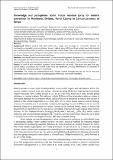| dc.contributor.author | STEPHEN MUNGA1, ZACHARY KIMWETICH2, FRANCIS ATIELI1, JOHN VULULE1and ELININGAYA J. KWEKA | |
| dc.date.accessioned | 2022-01-29T08:59:01Z | |
| dc.date.available | 2022-01-29T08:59:01Z | |
| dc.date.issued | 2017 | |
| dc.identifier.uri | https://repository.maseno.ac.ke/handle/123456789/4750 | |
| dc.description | Doi: http://dx.doi.org/10.4314/thrb.v19i4.2 | en_US |
| dc.description.abstract | Malaria control and intervention tools usage and coverage in community depend on community acceptability and compliance. Indoor residual spray (IRS) and long lasting insecticide treated nets (LLINs) are the preferred and recommended intervention tools. This study assessed the knowledge and perceptions about indoor residual spraying for malaria prevention in Mumberes division, Nandi County in Central Kenya. This cross-sectional study was carried out to determine KAP on malaria using IRS as a control tool for malaria transmission of the communities in Mumberes division of Koibatek district | en_US |
| dc.publisher | African journals online | en_US |
| dc.subject | : indoor residual spray, mosquitoes, malaria, transmission, knowledge, attitude, Kenya | en_US |
| dc.title | Knowledge and perceptions about indoor residual spray for malaria prevention in Mumberes division, Nandi County in Central province of Kenya | en_US |
| dc.type | Article | en_US |

